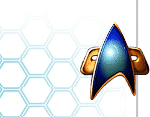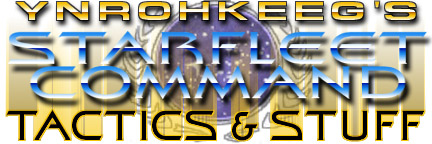
SFC Community SFC Volume III SFC Orion Pirates |
Sometimes they'll be right, sometimes not. Please let me know if the latter is true.
Energy Management If you've ever played Starfleet Command, you know that energy is a finite resource in the game. For beginning players, this can be a very frustrating limitation, and extremely difficult to master. After all, Starfleet Command is a Star Trek simulation, and we've always seen instances when "She canna take it! She dinna have the power!". Luckily for Kirk, he had a Legendary engineer that took care of all of that pesky energy business. Unfortunately for you, you have to keep track of everything yourself. So, let's get busy. The first thing to remember, which may or may not make you feel better, is that your opponent has the same energy limitations you have. He may have a ship that's bristling with armaments, but bigger weapons mean heavier power costs. It all comes down to management. You can't travel at speed 31 with overloaded photons, full ECM, and a tractor beam set to level 5. Neither can your opponent. SFC is a game of balance, not firepower. You must move slowly enough that your weapons charge, but quickly enough so that your opponent cannot run rings around you. You have to know the second when your weapons are charged, because that's when you can increase speed. Speed is the ultimate equalizer in SFC. The faster you're moving, the more likely you are to land an efficient attack, and you'll be better able to escape when he sets his sights on you. But speed is useless if you don't have the weapons or defenses necessary to resolve the conflict. To quote a British WWI fighter ace, "Good flying never killed (an enemy) yet". First of all, you must consider the type of ship you're commanding. If you're in a Frigate, movement costs less power, and you are much more maneuverable. You also have a much smaller reactor, so the energy you're saving from movement is critical for your weapons and other systems. If you're in a Battleship, the reverse is true. Movement costs a lot, and you turn like a pregnant Horta on anesthezine, but your reactor is generally big enough to handle weapons, movement, and a bunch of other stuff. For beginners, it's best to intimately learn your particular ship's characteristics before you fly one in multiplayer. Play single player and experiment. First of all, find a ship whose weapons compliment your personal style (long-range, short range, lots of marines… whatever you like). Then, take her out on a few shakedown cruises. Find out the fastest speed you can move while still charging weapons. With frigates, this is often around Speed 10, or maybe 15. You don't want to "trickle charge" your weapons; make sure they're charging as quickly as possible. You can take advantage of batteries if you like, depending on whether your weapons will charge completely before the batteries are depleted. You might need that extra energy later (and you can check your energy panel to see their status). Once you know your ship of choice, the next thing you must consider is your opponent. Launch a probe immediately at the nearest threat. Probes are essential for assessing a threat long before you are within weapons range. If the enemy has missiles, you'll have to spend some power on point defense or defensive tractors. If he has photons, you'll want to pump up your ECM. If he has an ESG, you'll need to maintain high speed and stay away from him. Find out what weapons he's using, and organize your energy strategy accordingly before you even come into contact. If you remember the old G.I. Joe cartoon, they always said that "Knowing is half the battle". Knowing what your enemy has is one of the most important aspects of this game, because it determines your playing style for the entire engagement. So, what do you need, and what is unnecessary? The things you must have, without a doubt, are speed and weapons. You need to maintain high speed, preferably faster than your opponent if at all possible. You also need to have weapons steadily charging. Everything else is determined by what your enemy is doing. Things like ECM, erratic maneuvers, tractor beams, and shield reinforcement are strictly "player's choice" options. They will not make or break a conflict in and of themselves, but sometimes they are necessary, depending on what your opponent is doing. If your enemy is using ECM, then ECCM is a wise option if you want to do maximum damage. If he's using huge amounts of missiles, high speed is preferable, but point defense and tractors are a valid alternative if you simply can't afford sustain speed 31. High speed, however, may allow you to "lead" missiles into asteroids or old mines. You can also drop a mine from your back hatch to shake off missiles that are getting too close for comfort. I'll get deeper into missile tactics in a later installment. Taking into account the wealth of defensive options, some are better than others. Shield reinforcement requires a lot more power than ECM, so ECM should be a priority over shield reinforcement. By the same token, if you're flying a ship with a low movement cost, such as a frigate, Erratic maneuvers are more cost effective than ECM, using about 1 point of energy for the same effect of 4 energy points for ECM. The disadvantage here is that those 4 ECM points are applied to your weapons as well, plus you can't launch shuttles or seeking weapons, nor can you transport. If you want to use erratic maneuvers, make sure you deactivate them right before firing, and reactivate them right after firing (hotkeys or Game Commander are great for this). Always keep in mind whether or not you are under erratic maneuvers, because you might be surprised by a sudden inability to fire that precious scatterpack or wild weasel you've been saving. Lyrans, particularly ones with multiple ESG's, tend to suck up a lot of power in the early stages of the battle (when they're generally charging phasers, disruptors, and the ESG simultaneously). On bigger ships, you'll barely be able to move at all and maintain a constant charge; at least at first. Once the ESG capacitor is charged, power consumption drops dramatically, allowing the Lyran much freedom to reallocate power. The best idea here is to avoid combat (ie: turn away from the enemy) until that capacitor is charged. All ships have this limitation to some extent, as the heavy weapons charge. One very important thing to remember is that as soon as your heavy weapons are fired, you will once again be hampered by energy constraints. You may keep your high speed, but your heavy weapons won't charge (or will do so extremely slowly). Performing an Alpha Strike (firing all weapons simultaneously) leaves you extremely vulnerable, but will also inflict maximum damage. So, there is a tradeoff here. After the initial discharge, you may want to take your heavy weapons offline until you can open enough distance to charge them safely at a lower speed. Romulans have a distinct energy disadvantage when using the cloaking device. The cloak sucks up so much power that movement slows to a crawl, and weapons charge dreadfully slowly. Some would say, and rightly so, that the restrictions of the cloaking device outweigh the advantages. Yeah, maybe you hardly take any damage from incoming fire, but the enemy can always get within point blank range and pummel you, and you can't return fire. Then, when you decloak, you're vulnerable. Experienced Romulan players rarely use the cloak for this reason. On the other hand, Romulans (and the Gorn) possess an energy advantage with their Plasma Torpedoes. Plasmas take a long time to charge, and do require a lot of energy, but that energy is split between the turns it takes to charge them. So, instead of sucking up lots of energy for a few turns, plasmas basically suck up a little power over several turns. This means that the Plasma-using ship will be able to maintain a higher speed while charging weapons than other races. Whatever your race, it is important to keep track of your "toggle-able" systems. Deep Scan is one of these, and it's used more often in single player than in multiplayer. I've noticed myself deep scanning (as required by a mission) and then engaging in battle, wondering why I'm doing so poorly. A deep scan uses 3 points of energy which can be very useful in a fight. Sometimes I forget to switch off that scanner, which is of very little use in combat. Oftentimes, these toggled systems are forgotten, leading to a combat disadvantage. The same holds true for ECCM. One opponent may be using a lot of ECM, and it's really easy to forget to check the ECM levels in the heat of battle. Defensive tractors are also useless if your enemy isn't using missiles. Make sure you check your energy screen if you're ever hurting for power. The screen will tell you where everything is going, so maybe you can shave off a few of your unnecessary expenditures. Anyway, that's about it for energy usage. It's the most important part of the game, but once you're used to it, it will be second nature. Next time, we'll cover missile tactics and missile defense. Missiles haven't been seen on Star Trek, but they are nonetheless a very big part of SFC. They can be a tremendous help or a tremendous nuisance, depending on the skill of the players. Anyway, I hope you learned at least a little about energy management, and I'll see you next time! 
|
| Site Design & Graphics by Jon MacLellan. |
